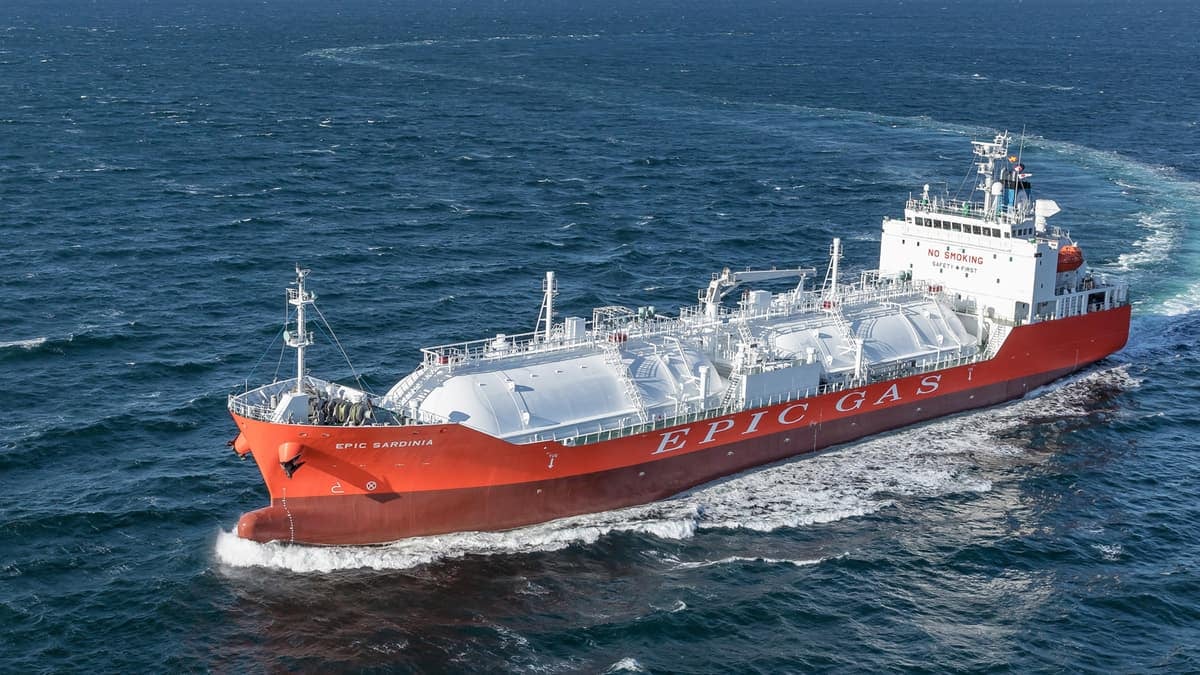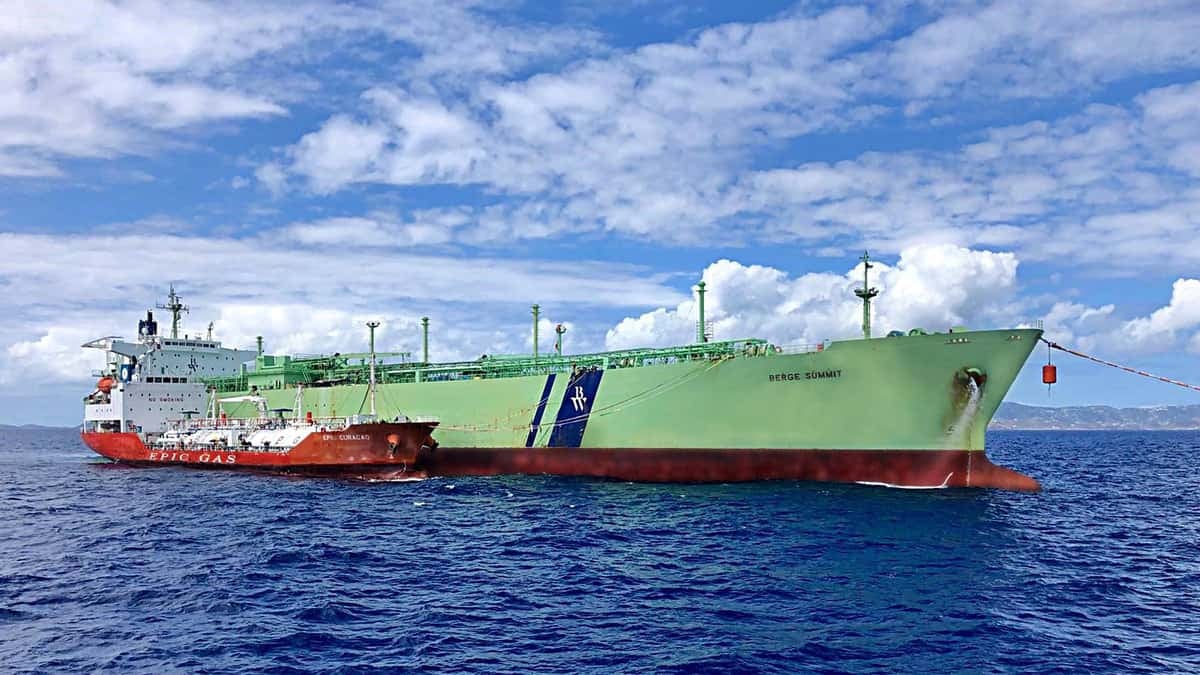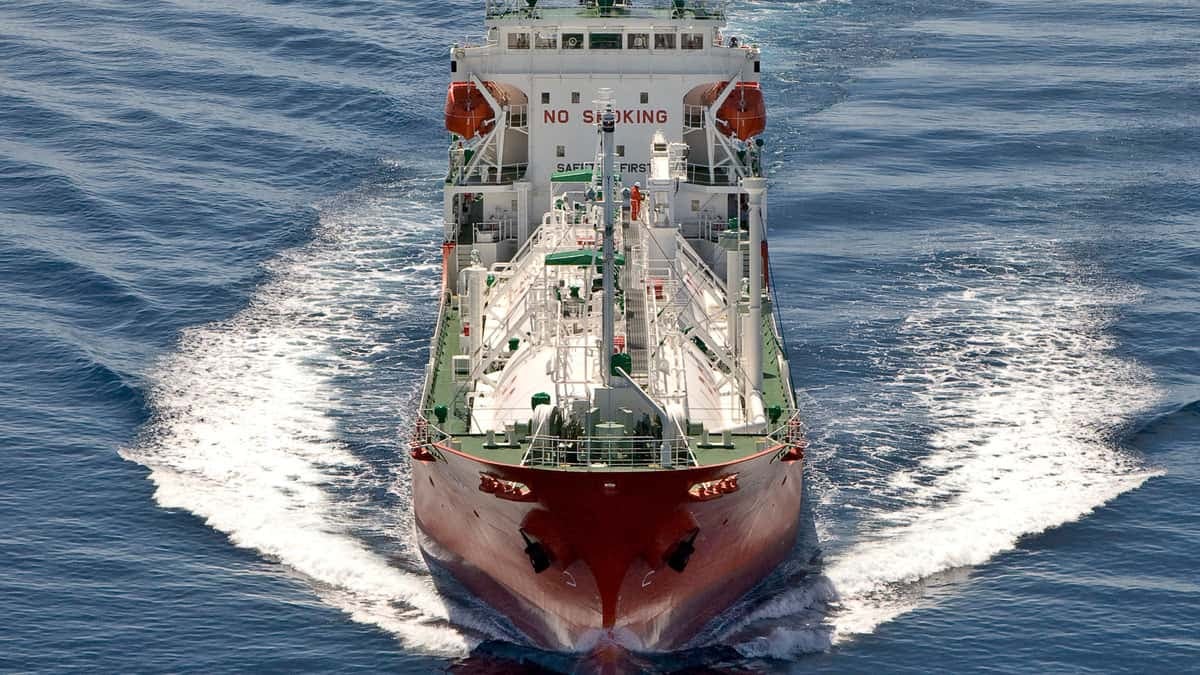Here’s a riddle: How can you be very small in ocean shipping and simultaneously very large? How can you cater to an extremely niche, defensible short-haul market with the smallest, least expensive vessels, but at the same time reap economies of scale available to the world’s largest big-ship, long-haul players?
Epic Gas (Oslo: EPIC-ME), which transports liquefied petroleum gas (LPG) and petrochemicals, appears to have found an answer.
During an in-depth interview with FreightWaves, Epic Gas chief executive officer Charles Maltby detailed a best-of-both-worlds business model that offers lessons other transport executives could learn from, even those who are not in ocean shipping.
Thinking small
“We wanted to find a niche and become the world’s best at it. The niche we identified is pressurized LPG,” explained Maltby.
LPG – primarily propane, secondarily butane – is carried aboard three main categories of ships: small, simply designed vessels with pressurized tanks that generally have capacity of 3,000-13,000 cubic meters (cbm); medium-sized ships with semi-refrigerated tanks; and larger ships with refrigerated tanks, dominated by 84,000 cbm very large gas carriers (VLGCs).
“The big petrochemical plants that invest hundreds of millions of dollars in a plant require high volumes of LPG, high volumes of storage and large ports. [Refrigerated] VLGCs are a very cheap and fantastic way of moving these volumes,” he said.
“At the other end of the scale, there’s the market for bottled gas, which is used for heating and cooking and small-scale power plants. The typical end user is often located in geographically diverse locations, often needing a small volume in a developing country with low population densities, a draft-restricted [shallow] port and smaller-scale storage.”
This kind of market calls for small pressurized LPG vessels. As Maltby put it, “You don’t need a hammer to crack a nut.
“Each pressurized LPG ship costs $15-30 million, which is significantly cheaper than semi-refrigerated or refrigerated vessels.
“The system aboard a pressurized ship is also fairly simple. It’s like two enormous barbecue gas bottles turned on their side. That’s about as complicated as it gets. Therefore, you’ve got lower debt amortization costs and lower operating expenses,” Maltby said.
Thinking big
Epic obtains scale advantages two ways: first, by being the largest fish in a small pond (pressurized carriers), and second, by securing a majority ownership stake from one of the biggest fishes in the biggest pond – the BW Group, one of the world’s premier ship-owning entities.

Epic owns 44 of ships ranging from 3,500-11,000 cbm in capacity – including four recently acquired 11,000 cbm vessels – and carries 3% of seaborne LPG (of its total volume, 75% is LPG and 25% is petrochemicals).
Maltby said that there are currently 330 pressurized LPG carriers trading globally among around 70 different owners. “That’s a lot of fragmentation, but if you ask, ‘How many of those owners are focused on pressurized LPG as their core sector?’ it’s just a handful, and if you then ask, ‘How many of those focused owners are trading globally?’ then the Venn diagram gets quite focused and suddenly there are not that many owners trying to do what Epic is trying to do.”
With regards to scale advantages through ownership, the BW Group controls hundreds of vessels in multiple shipping sectors. The BW Group’s intention to acquire at least 51% of Epic’s shares was announced on March 31. By April 16, the BW Group owned 82.9% of Epic’s stock.
BW has a combination of in-the-family companies in offshore, LPG, LNG, crude, chemicals and dry bulk, as well as affiliated companies it owns stakes in, including Epic, product tanker owner Hafnia Tankers (Oslo OTC: Hafnia), of which BW owns 65.3% and DHT Holdings (NYSE: DHT), of which BW owns 35%.
Fleet size advantages
FreightWaves asked Maltby whether Epic was growing its fleet to obtain cost savings and operating efficiencies, or alternatively, to be more attractive to investors in the capital markets and obtain lower capital costs.
In response, he maintained that any changes have to be about the customer, implicitly implying that growth can’t be for the sake of capital-market access alone. “The only point in doing anything is if it provides a better, safer, higher-quality, cheaper service to your customer,” he said. “If you don’t have a customer mandate, you don’t have a business. You can’t sell pink shoes to people who want to buy blue shoes.”

What a larger fleet does allow Epic is more flexibility. The company’s fleet has been built to be “fungible,” with high-quality assets maintained to the same standard that can be swapped from one contract to the next. The large number of ships and fungibility also allows for flexibility in terms of moving assets from the Atlantic Basin to the Pacific and vice versa, something that is more difficult for operators with fewer vessels.
Because Epic focuses on short-haul voyages (with an average of six days at sea per voyage) between smaller-scale terminals in predominantly developing economies, it necessarily deals with a large number of ports. According to Maltby, Epic makes more than 2,500 port calls at 200 to 250 different ports each year.
This offers two competitive advantages. First, the business relationships and port knowledge to do business at that many terminals equate to a barrier to entry; a new entrant would take time to develop that kind of experience.
Second, port and cargo diversity allows the fleet to increase utilization – the percentage of time ships are laden with cargo versus ballasting (empty) and repositioning. “We’ve built our whole business around maximizing utilization,” explained the CEO. The plethora of ports makes it easier to bring cargo from A to B, then B to C, and C to A, minimizing downtime versus VLGC markets, which often go from A to B full, then B to A empty. “In our worst quarter, our utilization was 90%,” he noted.
BW affiliate advantages
Maltby also offered new color on how the BW Group’s stake translates into Epic ’s benefits.
What it does not entail, at least currently, is a synergistic operational relationship between Epic Gas and BW’s in-house LPG unit, which focuses on VLGCs. For example, Epic pressurized vessels are not being coordinated to provide ship-to-ship transfer and last-mile delivery services for BW long-haul ships.
“We do some transshipment from their [BW LPG’s] vessels but it’s a very small percentage of our business and we don’t do it for them, we do it for another customer that just happens to be with their vessels. The investment is by BW Group at the parent level, not BW LPG. We haven’t really had any discussions with BW LPG.”
Asked whether the BW Group bought its Epic stake as a purely financial investment or to obtain future operational synergies, he said, “I don’t know the answer to that question because I’m not them.” However, he did explain specific benefits of Epic’s affiliation with the group.
“They have said that they will do anything they can to support Epic,” he explained. “They are tying us in with conversations on an intellectual basis with the rest of their investments when it comes to anything we can do to improve customer focus and tackle external factors such as the environment.”
Even though Epic is not directly involved in BW Group purchases of goods and services, there are still partnering opportunities that can lead to cost-savings synergies. “The bits you require for a pressurized LPG ship are completely different than those you require to run ships in the Hafnia, DHT or BW LPG fleets, but there are commonalities. Lube oils can often be negotiated at a bulk discount. The same for low-sulfur fuel oil.
“Also, I didn’t anticipate this, but we’re drydocking ships at the same [repair and maintenance] shipyards as other parts of the BW Group, and there are economies you can achieve with booking drydocking space. Insurance is another area we are reviewing,” he added.

There are also significant benefits when it comes to securing loans at a time when European banks are pulling back from ship finance.
“When we bought the most recent four vessels, BW was keen to support that investment,” reported Maltby. “The cost of the financing was about 30% lower than if BW hadn’t been involved. BW didn’t guarantee anything. But because it’s our largest shareholder, it enabled us to access more competitive debt financing.”
He emphasized that Epic is not a part of the BW Group. “It’s all done independently, working together as a team. It’s a subtle difference, but it’s working. It gives us the ability to access some of the scale of a 400-ship fleet and to provide the knowledge and benefits of the bigger business to our customers, while actually just cracking on as an independent business on a day-to-day basis.”
LPG market prospects
Epic’s advantages coincide with what is expected to be ongoing growth pattern in the seaborne trade of LPG.
More LPG is being pushed to sea by land-based production. Maltby noted that over 300 million tons per year of LPG is being produced, with 60% a byproduct of oil and natural gas drilling and 40% generating through the refining process. Exports were 55 million tons in 2010 and should surpass 100 million tons this year. “We expect LPG [at sea] to continue to grow steadily at a GDP-plus rate,” said Maltby.
On the demand side, he emphasized how LPG is viewed as a source of cleaner energy. “In many developing countries, there are government-sponsored schemes associated with reducing death and health issues from smoke inhalation from the burning of biomass for heating and cooking,” he said, citing markets like the Indian subcontinent, Africa and Asia.
“Bangladesh is a good example. In 2015, 88% of the population in a country with around 165 million people was burning biomass for heating and cooking. This country does have natural gas resources but it just cannot make a pipeline network work at this point in time. So it deregulated the LPG market, which has grown from 550,000 tons in 2017 to over 800,000 tons last year and is forecast to go up significantly higher this year,” he said, adding that the basic dynamic in Bangladesh can be seen in many other countries as well.
LPG rates
In the LPG sector, shipping analysts and press overwhelmingly focus on the headline VLGC rates, which have surged to unusually high levels this year. VLGC rates hit around $70,000 per day in late June, and are now down to a still respectable $47,000 per day.
Much less attention is focused on rates for smaller pressurized LPG vessels. Epic recently reported earning rates of $9,454 per day in the second quarter of 2019, up 4% year on year.
FreightWaves asked Maltby what the relationship was between rates of his company’s vessels and the high-profile VLGCs, given that the latter vessels have a completely different role in global trade.
There are connections between the two rate markets, he said. “If rates for VLGCs are $500,000 a month, it’s very difficult for us to ask $500,000 a month for an 11,000 cbm vessel. It’s not necessarily impossible and we have had and still have moments when we can earn the same as the big ships because we have niche trades where the big ships just can’t go. But if the VLGC rates go to a million dollars a month, it’s much easier for us to ask $500,000 a month for our vessels. So I do think there’s a ceiling [to Epic’s rates] that they [VLGCs] can lift when their rates go up.”
The second connection involves transshipment operations, wherein VLGCs handle the longer portion of the global voyage and pressurized carriers bring the LPG to the finish line. “Transshipment is now about 10-15% of our business compared to nothing four or five years ago,” said Maltby, who reported that Epic vessels were involved in ship-to-ship transfers in 25 countries in 2018.
“VLGCs are obviously a very cheap way to bring large volumes off the coast of a developing country, and what we’ve seen is that VLGC owners will do almost anything to keep their ships busy, even if that means sitting for a month off a small country or two dropping off volumes with a fairly basic return,” he continued.
However, when VLGC rates are very strong, as they were in 2014-15, VLGC owners are less likely to allow their vessels to sit offshore as long and serve as hubs for pressurized ships. This creates demand for smaller pressurized ships to take cargoes further distances.
Shipping demand is not measured in volume, but in volume multiplied by distance, or ton-miles. The higher the VLGCs rates, the more miles for pressurized vessels, thus the more ton-mile demand, which should increase rates for the smaller ships as well.
Theoretically, 2019’s VLGC rate strength should have positive side effects for Epic’s rates. “We anticipate that with the rate recovery for VLGCs, we’ll see more mile demand for our ships,” said Maltby. “That’s not just a hypothesis. That’s what we saw happening in previous years when rates were strong. With rates for big ships recovering, we see ourselves getting back some of the miles we lost in 2016 and 2017. And with the clean energy dynamic, we believe demand will just continue to grow.” More FreightWaves/American Shipper articles by Greg Miller








